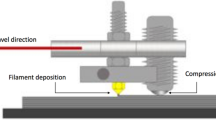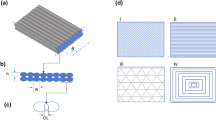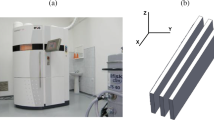Abstract
Fused filament fabrication (FFF) is widely used to obtain polymer-based composites with improved mechanical and thermal conduction properties. The effective properties of the composites are sensitive to their structure including the shape, distribution, and orientation of inclusions in the matrix and FFF-specific defects. The present work aims to study the formation of composite structure and relate it to the measured effective thermal conduction properties. Polymer flow in the hot end and the structure of printed samples are studied by metallography. The effective thermal diffusivity is measured by the laser flash method and analyzed by the Maxwell Garnett theory. Fibers in a polymer-matrix composite visualize polymer flow in the hot end of the FFF printer. In the nozzle, fibers are generally oriented parallel to the flow direction while gas bubbles may locally disturb flow and disorient fibers. Printed composite carbon fiber/TPU inherits the preferential orientation of fibers observed in the filament. Disorientation of fibers relative to the alignment direction increases after printing. In the printed Al2O3/PA composite, there is a lattice of triangle-based cylindrical pores parallel to the extrusion direction. Al2O3 particles are of irregular shape and approximately equiaxed. No segregation or agglomeration is observed. Significant anisotropy of thermal diffusivity is observed in the printed samples of 5%vol. carbon fiber/TPU composite. The measured effective thermal diffusivity of printed Al2O3/PA composites is essentially isotropic and significantly increases with the volume fraction of inclusions. In the studied FFF-printed composites, the effective thermal diffusivity is proportional to the thermal diffusivity of the polymer matrix, which is sensitive to its structure formed in non-equilibrium conditions of rapid quenching from the liquid phase.












Similar content being viewed by others
Abbreviations
- A :
-
Subexpression
- a :
-
Aspect ratio
- e :
-
Subexpression
- f :
-
Volume fraction
- h :
-
Layer height
- n :
-
Principal value of the depolarization tensor
- r :
-
Ellipsoid semi-axis
- T :
-
Temperature
- t :
-
Time
- α :
-
Thermal diffusivity
- h :
-
Hot end
- i :
-
Inclusion
- m :
-
Matrix phase
- γ :
-
Index
- ⊥:
-
Perpendicular
- ||:
-
Parallel
References
Kumar S, Singh R, Singh TP, Batish A (2023) Fused filament fabrication: a comprehensive review. J Thermoplast Compos Mater 36(2):794–814. https://doi.org/10.1177/0892705720970629
Dey A, Eagle INR, Yodo N (2021) A review on filament materials for fused filament fabrication. J Manuf Mater Process 5(3). https://doi.org/10.3390/jmmp5030069
Fallon JJ, McKnight SH, Bortner MJ (2019) Highly loaded fiber filled polymers for material extrusion: a review of current understanding. AdditManuf 30. https://doi.org/10.1016/j.addma.2019.100810
Athale M, Park T, Hahnlen R, Pourboghrat F (2022) Experimental characterization and finite element simulation of FDM 3D printed polymer composite tooling for sheet metal stamping. Int J Adv Manuf Technol 121:6973–6989. https://doi.org/10.1007/s00170-022-09801-0
Rivero-Romero O, Barrera-Fajardo I, Unfried-Silgado J (2023) Effects of printing parameters on fiber eccentricity and porosity level in a thermoplastic matrix composite reinforced with continuous banana fiber fabricated by FFF with in situ impregnation. Int J Adv Manuf Technol 125:1893–1901. https://doi.org/10.1007/s00170-022-10799-8
Shirinbayan M, Benfriha K, Tcharkhtchi A (2022) Geometric accuracy and mechanical behavior of PA6 composite curved tubes fabricated by fused filament fabrication (FFF). Adv Eng Mater 24(7). https://doi.org/10.1002/adem.202101056
Boparai K, Singh R, Singh H (2015) Comparison of tribological behaviour for Nylon6-al-Al2O3 and ABS parts fabricated by fused deposition modelling: This paper reports a low cost composite material that is more wear-resistant than conventional ABS. Virtual Phys Prototyp 10(2):59–66. https://doi.org/10.1080/17452759.2015.1037402
Kottasamy A, Samykano M, Kadirgama K, Rahman M, Mat Noor M (2022) Experimental investigation and prediction model for mechanical properties of copper-reinforced polylactic acid composites (Cu-PLA) using FDM-based 3D printing technique. Int J Adv Manuf Technol 119:5211–5232. https://doi.org/10.1007/s00170-021-08289-4
Camargo JC, Machado AR, Almeida EC, de Almeida VHM (2022) Mechanical and electrical behavior of ABS polymer reinforced with graphene manufactured by the FDM process. Int J Adv Manuf Technol. https://doi.org/10.1007/s00170-021-08288-5
Mader M, Hambitzer L, Schlautmann P, Jenne S, Greiner C, Hirth F, . . . Rapp BE (2021) Melt-extrusion-based additive manufacturing of transparent fused silica glass. Adv Sci 8(23). https://doi.org/10.1002/advs.202103180
Vozárová M, Neubauer E, Bača Ľ, Kitzmantel M, Feranc J, Trembošová V, . . . Matejdes M (2023) Preparation of fully dense boron carbide ceramics by fused filament fabrication (FFF). J European Ceram Soc 43(5):1751–1761. https://doi.org/10.1016/j.jeurceramsoc.2022.12.018
Pellegrini A, Palmieri ME, Guerra MG (2022) Evaluation of anisotropic mechanical behaviour of 316L parts realized by metal fused filament fabrication using digital image correlation. Int J Adv Manuf Technol 120(11–12):7951–7965. https://doi.org/10.1007/s00170-022-09303-z
Hamzah HH, Shafiee SA, Abdalla A, Patel BA (2018) 3D printable conductive materials for the fabrication of electrochemical sensors: a mini review. Electrochem Commun 96:27–31. https://doi.org/10.1016/j.elecom.2018.09.006
Hamzah HH, Keattch O, Covill D, Patel BA (2018) The effects of printing orientation on the electrochemical behaviour of 3D printed acrylonitrile butadiene styrene (ABS)/carbon black electrodes. Sci Rep 8(1). https://doi.org/10.1038/s41598-018-27188-5
Wang S, Chen M, Cao K (2022) Polymer composite with enhanced thermal conductivity and insulation properties through aligned Al2O3 fiber. Polymers 14(12). https://doi.org/10.3390/polym14122374
Cai Z, Thirunavukkarasu N, Diao X, Wang H, Wu L, Zhang C, Wang J (2022) Progress of polymer-based thermally conductive materials by fused filament fabrication: a comprehensive review. Polymers 14(20). https://doi.org/10.3390/polym14204297
Almuallim B, Harun WSW, Al Rikabi IJ, Mohammed HA (2022) Thermally conductive polymer nanocomposites for filament-based additive manufacturing. J Mater Sci 57(6):3993–4019. https://doi.org/10.1007/s10853-021-06820-2
Chen J, Huang X, Sun B, Jiang P (2019) Highly thermally conductive yet electrically insulating polymer/boron nitride nanosheets nanocomposite films for improved thermal management capability. ACS Nano 13(1):337–345. https://doi.org/10.1021/acsnano.8b06290
Shaqour B, Abuabiah M, Abdel-Fattah S, Juaidi A, Abdallah R, Abuzaina W, . . . Cos P (2021) Gaining a better understanding of the extrusion process in fused filament fabrication 3D printing: a review. Int J Adv Manuf Technol 114(5–6):1279–1291. https://doi.org/10.1007/s00170-021-06918-6
Mostafa N, Syed HM, Igor S, Andrew G (2009) A study of melt flow analysis of an ABS-iron composite in fused deposition modelling process. Tsinghua Sci Technol 14(SUPPL. 1):29–37. https://doi.org/10.1016/S1007-0214(09)70063-X
Shadvar N, Foroozmehr E, Badrossamay M, Amouhadi I, Dindarloo AS (2021) Computational analysis of the extrusion process of fused deposition modeling of acrylonitrile-butadiene-styrene. IntJ Mater Form 14(1):121–131. https://doi.org/10.1007/s12289-019-01523-1
Mishra AA, Momin A, Strano M, Rane K (2022) Implementation of viscosity and density models for improved numerical analysis of melt flow dynamics in the nozzle during extrusion-based additive manufacturing. Prog Addit Manuf 7(1):41–54. https://doi.org/10.1007/s40964-021-00208-z
Ufodike CO, Nzebuka GC (2022) Investigation of thermal evolution and fluid flow in the hot-end of a material extrusion 3D printer using melting model. Addit Manuf 49. https://doi.org/10.1016/j.addma.2021.102502
Chen H, Ginzburg VV, Yang J, Yang Y, Liu W, Huang Y, . . . Chen B (2016) Thermal conductivity of polymer-based composites: fundamentals and applications. Prog Polym Sci 59:41–85. https://doi.org/10.1016/j.progpolymsci.2016.03.001
Phan DD, Swain ZR, MacKay ME (2018) Rheological and heat transfer effects in fused filament fabrication. J Rheol 62(5):1097–1107. https://doi.org/10.1122/1.5022982
Filamentarno (07.10.2023) https://filamentarno.ru/id=65
Smirnov A, Seleznev A, Peretyagin P, Bentseva E, Pristinskiy Y, Kuznetsova E, Grigoriev S (2022) Rheological characterization and printability of polylactide (PLA)-alumina (Al2O3) filaments for fused deposition modeling (FDM). Materials 15(23). https://doi.org/10.3390/ma15238399
Bottger PHM, Gusarov AV, Shklover V, Patscheider J, Sobiech M (2014) Anisotropic layered media with microinclusions: thermal properties of arc-evaporation multilayer metal nitrides. Int J Thermal Sci 77:75–83. https://doi.org/10.1016/j.ijthermalsci.2013.10.011
Inamdar TC, Wang X, Christov IC (2020) Unsteady fluid-structure interactions in a soft-walled microchannel: a one-dimensional lubrication model for finite Reynolds number. Phys Rev Fluids 5(6). https://doi.org/10.1103/PhysRevFluids.5.064101
Howard CV, Reed MG. Unbiased Stereology (2005). 2nd ed. Garland Science/BIOS Scientific New York, ISBN: 978–1859960899
Pinedo B, Hadfield M, Tzanakis I, Conte M, Anand M (2018) Thermal analysis and tribological investigation on TPU and NBR elastomers applied to sealing applications. Tribol Int 127:24–36. https://doi.org/10.1016/j.triboint.2018.05.032
Huang X (2009) Fabrication and properties of carbon fibers. Materials 2(4):2369–2403. https://doi.org/10.3390/ma2042369
Null MR, Lozier WW, Moore AW (1973) Thermal diffusivity and thermal conductivity of pyrolytic graphite from 300 to 2700° K. Carbon 11(2):81–87. https://doi.org/10.1016/0008-6223(73)90058-4
Ogawa M, Mukai K, Fukui T, Baba T (2001) The development of a thermal diffusivity reference material using alumina. Meas Sci Technol 12(12):2058–2063. https://doi.org/10.1088/0957-0233/12/12/305
Dos Santos WN, Mummery P, Wallwork A (2005) Thermal diffusivity of polymers by the laser flash technique. Polym Testing 24(5):628–634. https://doi.org/10.1016/j.polymertesting.2005.03.007
Torquato S (2002) Random Heterogeneous Materials, Springer. ISBN: 978–1–4757–6355–3
Zhang R, Jariyavidyanont K, Du M, Zhuravlev E, Schick C, Androsch R (2022) Nucleation and crystallization kinetics of polyamide 12 investigated by fast scanning calorimetry. J Polym Sci 60(5):842–855. https://doi.org/10.1002/pol.20210813
Kittel C (2005) Introduction to Solid State Physics. 8th Edition, Wiley. ISBN: 978–0–471–68057–4
Cahill DG, Watson SK, Pohl RO (1992) Lower limit to the thermal conductivity of disordered crystals. Phys Rev B 46(10):6131–6140. https://doi.org/10.1103/PhysRevB.46.6131
Salameh B, Yasin S, Fara DA, Zihlif AM (2021) Dependence of the thermal conductivity of PMMA, PS and PE on temperature and crystallinity. Polymer (Korea) 45(2):281–285. https://doi.org/10.7317/pk.2021.45.2.281
Acknowledgements
The experiments were carried out using the equipment of the Centre of collective use of MSUT “STANKIN” (project No. 075-15-2021-695).
Funding
This work was supported by Ministry of Science and Higher Education of the Russian Federation under project 0707–2020-0034.
Author information
Authors and Affiliations
Contributions
Conceptualization: AG, AS. Investigation: EK, MG, NB, NWSP, RK. Supervision: AS. Writing—original draft: AG, RK. Writing—review and editing: AG, AS.
Corresponding author
Ethics declarations
Ethical approval
Not applicable.
Consent to participate
Not applicable.
Consent to publication
Not applicable.
Conflict of interest
The authors declare no competing interests.
Additional information
Publisher's Note
Springer Nature remains neutral with regard to jurisdictional claims in published maps and institutional affiliations.
Rights and permissions
Springer Nature or its licensor (e.g. a society or other partner) holds exclusive rights to this article under a publishing agreement with the author(s) or other rightsholder(s); author self-archiving of the accepted manuscript version of this article is solely governed by the terms of such publishing agreement and applicable law.
About this article
Cite this article
Smirnov, A., Pinargote, N.W.S., Khmyrov, R. et al. Structure formation and thermal conduction in polymer-based composites obtained by fused filament fabrication. Int J Adv Manuf Technol 129, 2677–2690 (2023). https://doi.org/10.1007/s00170-023-12432-8
Received:
Accepted:
Published:
Issue Date:
DOI: https://doi.org/10.1007/s00170-023-12432-8




